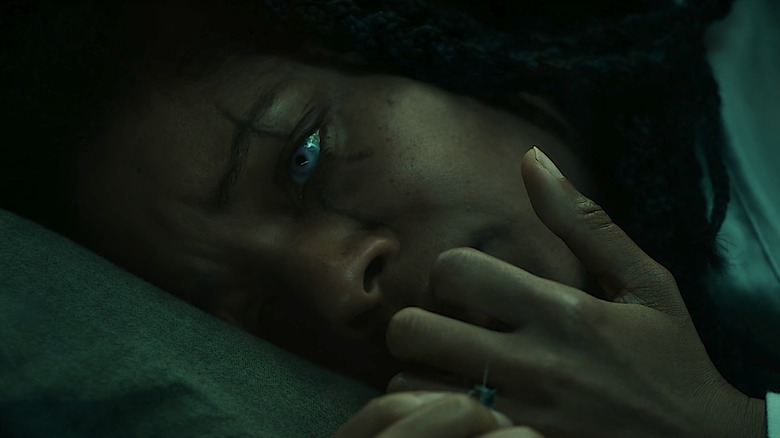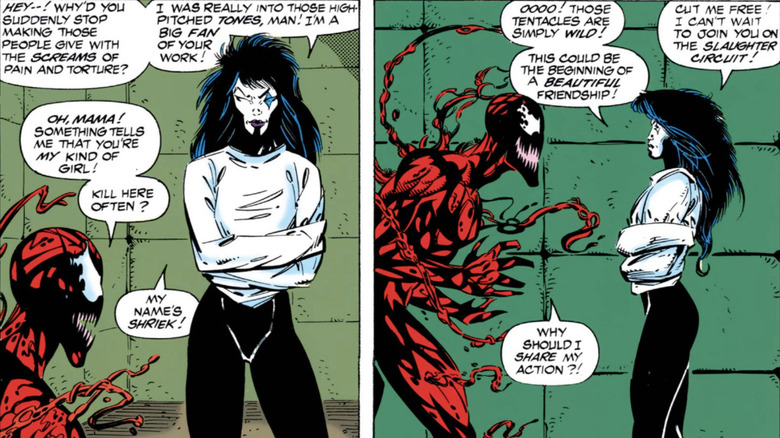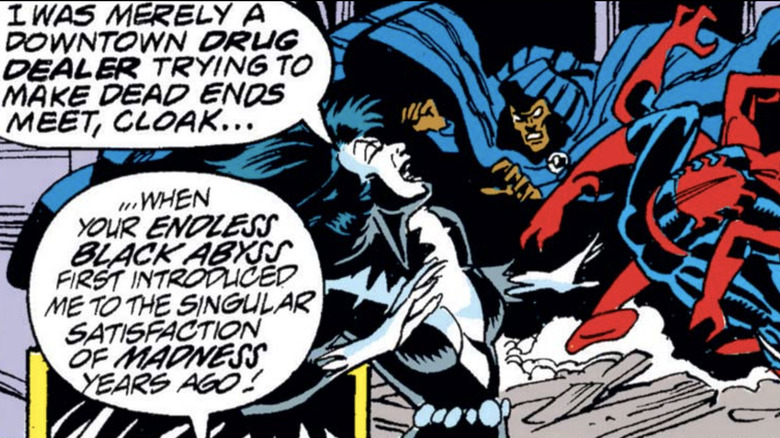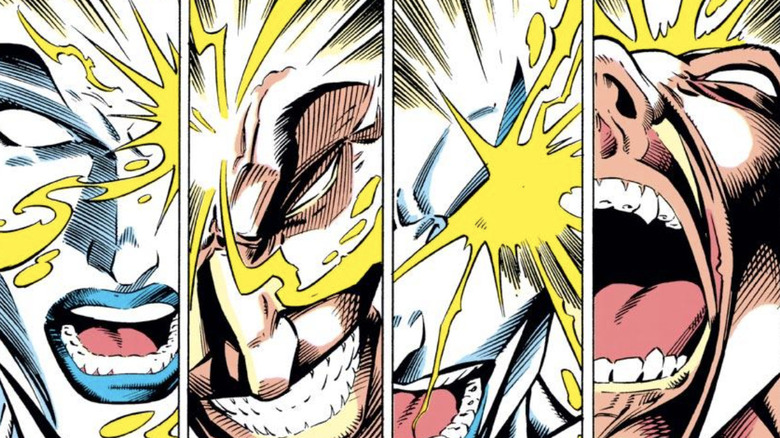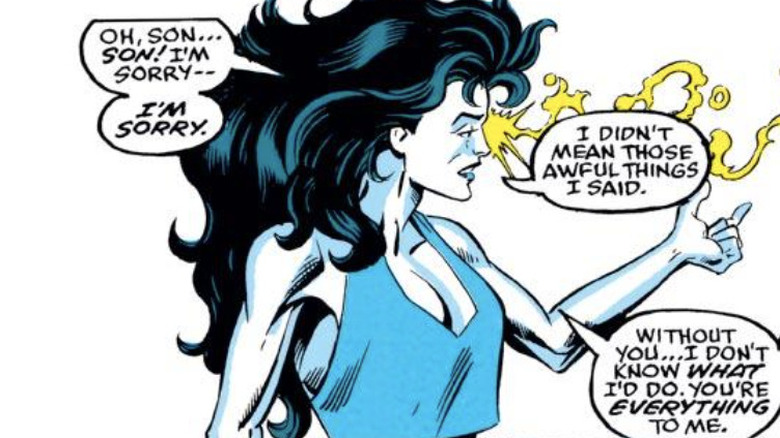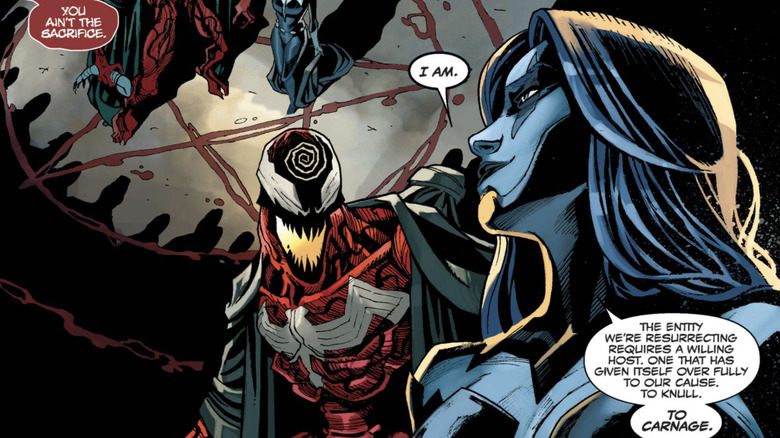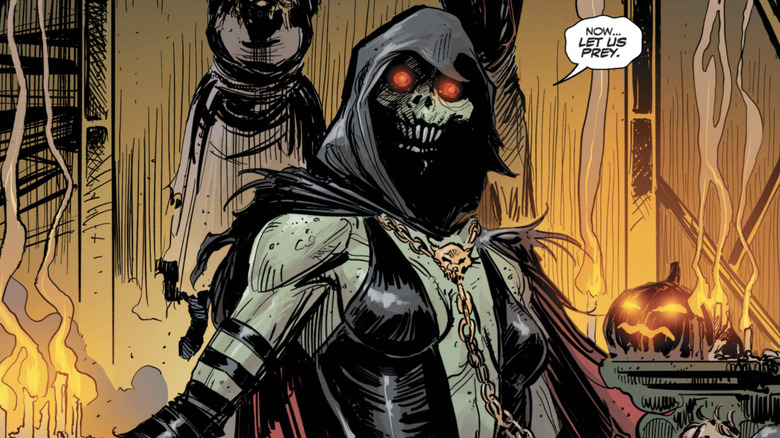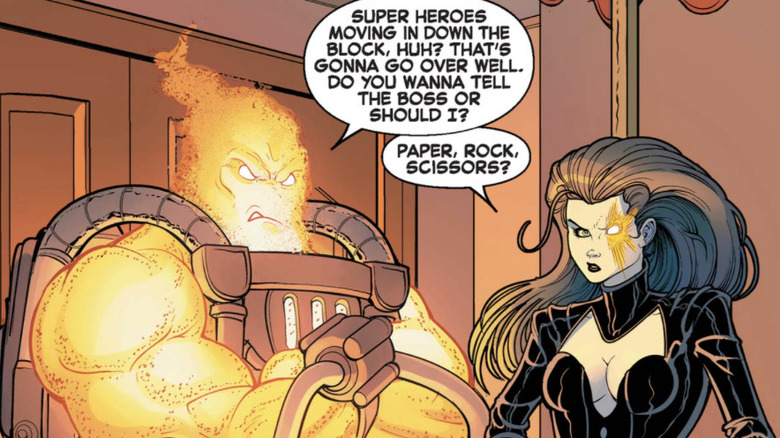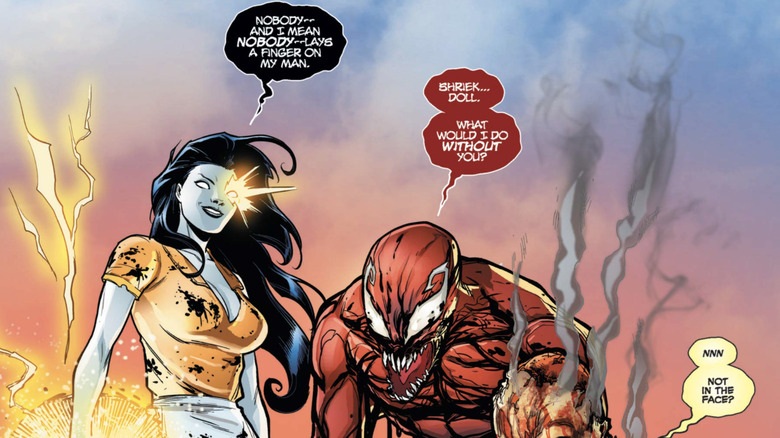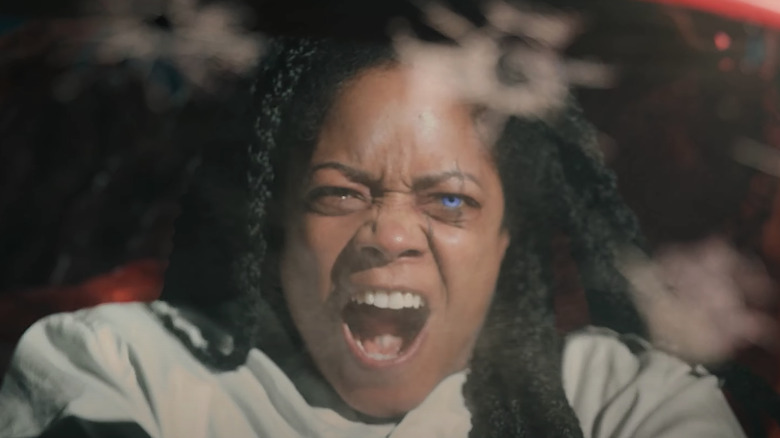Who Is Shriek In The Marvel Universe?
With "Venom: Let There Be Carnage," much of the gang is back — both those born on Earth, and otherwise. Tom Hardy is back as Eddie Brock, alongside his titular symbiote companion, who is once again eating people and calling Eddie a loser and just being generally delightful. Michelle Williams and Reid Scott reprise their roles as Eddie's ex-girlfriend, Anne Weying, and her fiancé, Dan Lewis, continuing the love triangle from the first film. Of course, Woody Harrelson, teased as serial killer Cletus Kasady in the post-credits scene of 2018's off-the-wall and out-of-left-field hit "Venom," finally takes center stage, transforming into the mass-murdering supervillain known as Carnage.
The trailers for the film, however, unveiled a character viewers of the original film have not seen before. Her name is Frances Barriston (and she's played by Naomie Harris from the "Pirates of the Caribbean" movies), but she's better known to Marvel Comics fans as Shriek, Carnage's lover and longtime partner-in-crime.
Since the trailers don't show her interacting with any of the other main characters, the exact nature of her involvement is unclear; taking a look at her comic book history, however, could provide valuable insight. Particularly because she's a pretty obscure character even for comic readers, many of whom have likely never heard of her.
With this in mind, here's the low-down on the latest character to join the Marvel universe, via her Marvel Comics past. But first, a word of warning: Talking about Shriek is inextricably linked to discussions of abusive relationships, mental illness, trauma, and child abuse.
She's a Carnage character
This may seem obvious, as she's appearing in the Carnage movie, but it's worth emphasizing: Shriek's association with Carnage is indelible, and she only rarely shows up in comics without him.
She was created by writer and editor Tom DeFalco and introduced in "Spider-Man Unlimited" #1, the first installment of the sprawling Spider-Man crossover storyline "Maximum Carnage." In fact, it's Carnage himself who first introduces us to Shriek, during his escape from the Ravencroft Institute for the Criminally Insane. As he's slaughtering guards and orderlies, he hears another Ravencroft inmate cheering him on. Curious, he discovers Shriek in a nearby cell, wrapped in a straight jacket and very excited about the horror show. She convinces Carnage to free her, and the two of them engage in both a twisted romance and a campaign of chaos and murder that stretches across 14 issues of comics.
While there have been occasional attempts to use Shriek as a character in her own right, none of them have ever stuck. From her first appearance in 1993 to her (apparent) death in 2019, she has been almost entirely defined as Carnage's love interest, inevitably turning up whenever he does. Considered in that light, it's no wonder that a version of Shriek will be featured in "Let There Be Carnage" — wherever Carnage goes, Shriek inevitably follows.
Her origin story involves Cloak and Dagger
The movie version of Shriek will likely be somewhat different from the comic book version for a number of reasons, but the biggest one involves how she got her superpowers. Shriek is supposedly a mutant, similar to the X-Men, or at least that's what her rendition of an origin story would seem to indicate (we never actually get to see it on the page, Shriek merely tells other characters about it). According to her, she was a drug dealer whose powers were awakened by the hero known as Cloak, whose body is a portal to an alternate plane of existence called the Darkforce Dimension. Being enveloped in Cloak's cloak often results in criminals experiencing terrifying visions of their greatest fears, and can result in them going insane. That's exactly what happened to Shriek — only in her case, the loss of her sanity coincided with her newfound abilities.
None of this is likely to be translated to the movie, of course. For one thing, Cloak and his crimefighting partner, Dagger, are currently the property of Marvel Studios, and were recently the stars of their own short-lived TV series on Freeform. For another, mutants as a concept are now once again in the hands of Marvel following their re-acquisition of the X-Men from 20th Century Fox, so Shriek will probably need another backstory entirely — although honestly, most people assume she's a mutant in the absence of any other explanation. The film could go in virtually any direction.
Her powers are nebulous, but intriguing
Speaking of Shriek's superpowers ... what are they? Viewers of the "Let There Be Carnage" trailers can clearly see that she's doing something with her voice, and that's true. Shriek's primary power is her ability to manipulate sound, which usually takes the form of blasts of sonic energy. As you might expect, this is bad news for symbiotes, who are vulnerable to sound, but the concussive force of Shriek's attacks can do extreme physical damage to normal people as well (she can also use them to fly somehow). But despite being the power she's named for, in the comics, her sonic abilities are actually the least terrifying weapon in Shriek's arsenal.
Beyond sound manipulation, Shriek also seems to have an undefined degree of psychic power. She has demonstrated limited telekinesis by levitating people and objects, but more interestingly, she can reach into the minds of others, locating the darkest parts of their personalities and drawing them to the forefront. She has used this ability on Spider-Man in an attempt to turn him to the dark side, and on the Ravencroft inmate Malcolm McBride as well, re-awakening his villainous alter ego, Carrion. Over the course of "Maximum Carnage," her powers affected the entire city of New York, plunging it into a chaos driven by humanity's darkest impulses. There's no telling what the full nature of her powers will be in "Let There Be Carnage," but it's safe to assume they will be more than just sonic blasts.
Her story is about trauma and abuse
At first glance, Shriek may seem like your run-of-the-mill psychopath, but there's actually a lot more to her than that. While she didn't do a whole lot in the wake of "Maximum Carnage," the character was fleshed out by writer J.M. DeMatteis in a four-issue Spider-Man story called "Shrieking," which played out over the course of "Amazing Spider-Man" #390-393.
DeMatteis' tale digs deeper into Shriek's most interesting character trait: her desire for a family. "Maximum Carnage" had already introduced this idea, with Shriek and Carnage serving as twisted parental figures for fellow villains Doppelganger, Demogoblin, and Carrion, but "Shrieking" takes it much further, as Shriek essentially kidnaps Malcolm McBride (whose "Carrion virus" has been successfully suppressed) from Ravencroft. Shriek still considers Carrion her son, and moreover, she's convinced McBride's actual mother doesn't really love him.
This, as it turns out, is because Frances Barriston did not have loving parents. Her childhood was filled with a wide variety of abuse, and the trauma she endured at her family's hands left deep scars on her psyche. Her need to be a mother to Carrion is rooted in her desire to embody the kind of mother she never had — which is why, when she finally realizes that McBride's mother does actually love him, she lets him go, taking the Carrion virus into herself. It's a surprisingly moving, compelling story — especially considering that Shriek would essentially be absent from comics for the ensuing 15 years.
She's a tragic villain
After "Shrieking," Frances Barriston's status as a tragic villain was already pretty well established, but the real tragedy was yet to come. Minus one or two extremely minor appearances, Shriek didn't appear in Marvel Comics from 1995 to 2010. She was brought back for a five-issue "Carnage" mini-series starring Spider-Man and Iron Man, which begins with Shriek having made some real progress in her therapy thanks to Dr. Tanis Nieves. However, when the ruthless corporation Hall Industries makes her a pawn in a scheme to weaponize the Carnage symbiote, Shriek ends up relapsing into her violent ways (through no fault of her own) and returning to Carnage's side. Even Nieves, her doctor, who by then had merged with a symbiote of her own to become Scorn, turned on Shriek, comparing her to a dog who needs to be put down and placing her in a coma.
After that, Shriek's main appearances consist of her coming back to Carnage again and again, no matter how abusive he is towards her. Finally, in "Absolute Carnage: Lethal Protectors" #1, she willingly sacrifices herself to Carnage's newfound religious cause, allowing him to rip out her spine. It's all well and good to tell interesting stories with a character who comes from a background of abuse, but to then do nothing more with her beyond constantly returning to the side of her abusive lover — until he kills her — is a pretty brutal tragedy.
She might be a demon now
Of course, no one is dead forever in comic books, and despite the traumatic end to her story, there's actually a very clear path for Shriek's eventual return. In fact, you could argue that she's returned already.
Considering the themes that surround her character, the entire point of her sacrifice in "Absolute Carnage" felt fitting, as she yearned for the resurrection of one of her "children" from "Maximum Carnage" — Demogoblin, a literal demon from the infernal realm of limbo with a religious obsession over punishing sinners. Having possessed Shriek's body, the demon began presenting as female, calling itself Demagoblin (note the slight change in spelling). Between Carnage referring to Demagoblin as being "merged with Shriek" and the two immediately engaging in a romantic relationship, it seems logical that Shriek is still in there somewhere. And Demo/Demagoblin has a history of ripping free of its host body, restoring the host's original form.
Whether or not we'll ever find out for sure if Shriek is still in there depends on what happens with Demagoblin. After "Absolute Carnage," she appeared as a last-page reveal in "Scream: Curse of Carnage" #6 (another series about a symbiote), but that turned out to be the last issue, as the book was delayed due to the COVID-19 pandemic and subsequently canceled. None of the demon stuff is likely to make it into the film, but it's possible that "Let There Be Carnage" will get enough people interested in Shriek that somebody will remember she's still out there, possibly possessed by an uncharacteristically pious demon.
She has randomly appeared in some strange places
Just because Shriek is primarily linked to Carnage, that doesn't mean she has only appeared in Carnage comics. Aside from "Shrieking," the one story that actually centers around her, she has had scattered cameos in a wide variety of books. Following the "Carnage" miniseries, she was one of Caroline Le Fay's Doom Maidens in the 2013-2014 series "Fearless Defenders" before becoming a member of the Sinister Sixteen in the pages of "Superior Foes of Spider-Man." Both series were excellent, but Shriek didn't get much of a chance to shine in them, as in both instances she was just one part of a much larger team.
In 2016, she briefly appeared (though wasn't named) in "Spider-Woman" #1, and later got a slightly larger role in the first couple issues of "Great Lakes Avengers," where she can be seen working as an enforcer for Detroit villain Nain Rouge and exchanging quips with her fellow hired thug, Firebrand. In 2018, Shriek finally came full circle, returning to symbiote territory by attacking Venom in "Venom" #157 before getting involved with Carnage one last time in the "Absolute Carnage" storyline. It's a truly bizarre comic book, and most of it remains resolutely spider-themed, cementing Shriek's role in the wider canon of Spider-Man villains.
She is often compared to Harley Quinn
One reason to be hopeful about a potential surge of Shriek interest generated from "Let There Be Carnage" is related to another, far more popular comic book character: DC Comics' Harley Quinn.
The comparisons between the two are unmistakable. Just like Shriek, Dr. Harleen Quinzel had a longstanding romantic relationship with a psychotic murderer she met in an insane asylum — albeit, while Harley was a doctor rather than an inmate, causing her to lose her sanity. Harley's relationship with the Joker is famously abusive — so much so that it became the central premise of both the "Harley Quinn" animated series and the "Birds of Prey" film — and calls to mind Shriek's relationship with Carnage. The difference, of course, is that Harley is a fan favorite who eventually got to break free from the Joker and have adventures on her own, while Shriek has languished in obscurity.
While she was already well-regarded, there has been a very good reason for Harley Quinn's spike in popularity in recent years. She has been played on screen by Margot Robbie, a twice-Oscar-nominated actress who seems to have thrown herself into the role with joyful abandon, frequently stealing scenes. This would seemingly make it very easy to greenlight new Harley Quinn movies, as long as Robbie continues portraying the character. For her part, Shriek also has landed a solid, Oscar-nominated — if less recognizable to your average moviegoer — actor to bring her to life.
She'll be played by Naomie Harris
The first "Venom" wasn't what you'd call a prestige film, and the sequel appears to be carrying on in the same tone. That said, it's very interesting that the movie stars English actor Naomie Harris, who is famously selective about the roles she takes.
Harris burst onto the cinema scene in 2002 as Selena in the zombie movie "28 Days Later," for which she won the Black Reel Award for Outstanding Breakthrough Performance. In the two ensuing decades, she has appeared in some blockbuster franchises, as she played Calypso in the "Pirates of the Caribbean" movies and will reprise her role as Eve Moneypenny for the third time in the James Bond film "No Time To Die."
In 2016, Harris earned an Academy Award nomination for her portrayal of Paula, the lead character's abusive drug addict mother in "Moonlight." It was a change for her (Harris had previously vowed to only appear in movies that shone a positive light on Black women), but it makes her casting as Shriek strangely appropriate. Considering Harris' proclivities as a performer, her Frances Barriston could be very special — and perhaps finally make a household name of an actor (and character) deserving of more attention than she has received.
